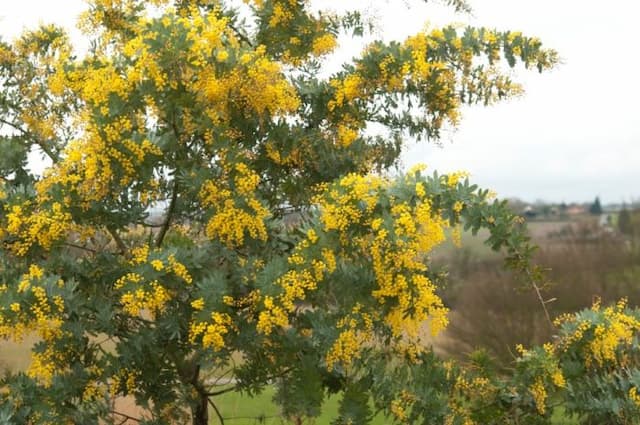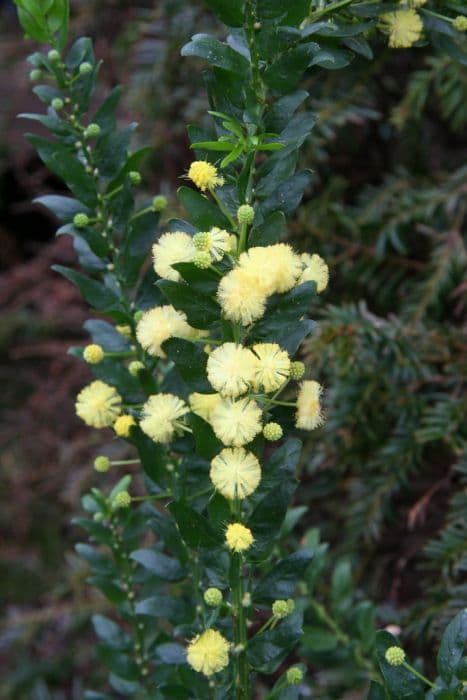Black Medic Medicago lupulina






ABOUT
Black medick is a perennial herb with a visually appealing appearance owing to its trifoliate leaves, which are characteristic of the clover family, to which it belongs. Each leaf consists of three oval to heart-shaped leaflets that bear a resemblance to those of clover, but without the white markings often found on clover leaves. It blooms with tiny, bright yellow flowers that are clustered into compact, spherical heads. These flower heads give a lively splash of color to the plant's green foliage during its blooming season. The flowers eventually give way to small, kidney-shaped seed pods, which are coiled and turn black when mature, contributing to the plant's common name. The plant itself forms a low-growing mat or carpet, which spreads across the ground, often unnoticed until it comes into bloom. Its stems are slender and can be either upright or prostrate, sprawling across the soil. Black medick's growth habit can make it look like a lush green carpet sprinkled with golden yellow dots when in full flower.
About this plant
 Names
NamesFamily
Fabaceae.
Synonyms
Black Medick, Black Hay, Hop Clover, Yellow Trefoil, Nonesuch, Hop Medic.
Common names
Medicago apiculata, Medicago lupulina var. glandulifera, Medicago lupulina var. willdenowii, Medicago polymorpha var. lupulina, Trigonella lupulina.
 Toxicity
ToxicityTo humans
Black medic (Medicago lupulina) is generally not considered toxic to humans. While it is not a common dietary item and not typically ingested, if accidental ingestion were to occur, in typical amounts, it is unlikely to cause serious harm or poisoning symptoms. However, it's always advisable to eat plants only when you are certain they are safe for consumption and to consult with a medical professional if any adverse reactions are observed.
To pets
Black medic (Medicago lupulina) is also generally not considered highly toxic to pets. It is a common weed found in various environments. While it is not a part of a normal diet for pets, accidental ingestion in small quantities typically does not result in poisoning. However, as with humans, ingestion of non-food plants by pets should be avoided, and if a pet does consume a considerable amount of black medic or shows any signs of distress after ingestion, a veterinarian should be consulted.
 Characteristics
CharacteristicsLife cycle
Annuals
Foliage type
Deciduous
Color of leaves
Green
Flower color
Yellow
Height
1-2 feet (0.3-0.6 meters)
Spread
1-2 feet (0.3-0.6 meters)
Plant type
Herb
Hardiness zones
3-9
Native area
Europe
Benefits
 General Benefits
General Benefits- Nitrogen Fixation: Medicago lupulina, commonly known as black medick, improves soil fertility by fixing nitrogen through its symbiotic relationship with root-nodulating Rhizobium bacteria.
- Erosion Control: As a ground-cover plant, black medick helps to prevent soil erosion with its dense mat-forming growth habit.
- Forage for Livestock: Black medick is used as a forage crop for grazing animals due to its high-quality, nutritious foliage.
- Green Manure: It can be used as green manure to enrich the soil with organic matter when plowed back into the ground as it decomposes.
- Supports Biodiversity: This plant provides habitat and food for a variety of insects and animals, supporting ecological diversity.
- Ornamental Use: With its small yellow flowers, black medick is sometimes grown for ornamental purposes in gardens and landscapes.
- Grassland Improvement: Black medick is often included in grass seed mixes to improve the quality of pastures and grasslands for grazing.
- Drought Resistance: It is relatively drought-tolerant once established, making it suitable for xeriscaping and low-water-use gardens.
 Medical Properties
Medical Properties- Anti-inflammatory: Commonly known as black medick or nonesuch, it has been traditionally used due to its purported anti-inflammatory effects.
- Diuretic: Black medick has been used to promote urine flow and relieve fluid retention.
- Astringent: The astringent qualities of black medick have been utilized for managing minor wounds and skin irritations.
 Air-purifying Qualities
Air-purifying QualitiesThis plant is not specifically known for air purifying qualities.
 Other Uses
Other Uses- Medicago lupulina, commonly known as black medick, is used as a green manure and cover crop, improving soil structure and fertility due to its nitrogen-fixing capabilities.
- The plant has been historically used to curdle milk in cheese-making processes as it contains coagulating properties.
- As an ornamental plant, black medick provides ground cover with its sprawling habit and small yellow flowers, adding visual appeal to gardens or landscaped areas.
- In some cultures, black medick has been used to make a yellow dye for textiles, albeit not a primary use, using the flowering parts that yield the color.
- The plant functions as fodder for grazing livestock, particularly appealing to sheep, due to its nutritional content and palatability.
- Black medick is occasionally used in honey production, as bees are attracted to its flowers, contributing to the biodiversity of the honey.
- It can act as a biological control agent by outcompeting more noxious weeds, thus used in integrated weed management practices.
- The plant has been used in agroforestry systems for the purpose of landscape restoration, especially in areas where soil erosion is a concern.
- Black medick has been used in crafting and decoration, where dried flowers and leaves add a rustic touch to bouquets and wreaths.
- In seed mixtures for wildlife habitats, black medick is incorporated to provide a food source for small mammals and birds.
Interesting Facts
 Feng Shui
Feng ShuiThe Black Medick is not used in Feng Shui practice.
 Zodiac Sign Compitability
Zodiac Sign CompitabilityThe Black Medick is not used in astrology practice.
 Plant Symbolism
Plant Symbolism- Nourishment: Medicago lupulina, commonly known as Black Medick, is often considered a symbol of nourishment due to its role as a forage plant for livestock, indicating the provision of life's essentials.
- Healing: In traditional medicine, Black Medick has been used for its purported medicinal properties, representing healing and the relief of ailments.
- Fertility: As a legume, Black Medick is able to fix nitrogen in the soil, representing fertility and the idea of bringing life and growth to the land.
- Resilience: Black Medick's ability to thrive in various soil conditions symbolizes resilience and the capacity to overcome environmental adversity.
 Water
WaterBlack Medick should be watered moderately, being careful not to overwater as it tolerates drought fairly well. Generally, it is sufficient to water once a week, providing about an inch of water per session. During particularly hot or dry periods, an additional watering may be necessary but always check the soil moisture first. Excess water should be avoided, as Black Medick does not like soggy conditions. Established plants will require less water, thanks to their efficient root systems.
 Light
LightBlack Medick thrives in full sunlight to light shade. It performs best when planted in a spot that receives at least six hours of direct sunlight per day. Slightly shaded areas are acceptable, as long as the plant gets a good amount of morning light or filtered sunlight throughout the day.
 Temperature
TemperatureBlack Medick prefers temperate climates and grows well in temperatures ranging from 60 to 70 degrees Fahrenheit. The minimum temperature for survival is just below freezing, while it can tolerate high temperatures as long as it is not prolonged exposure to heat above 90 degrees Fahrenheit. The ideal temperature condition for Black Medick is between 65 to 75 degrees Fahrenheit.
 Pruning
PruningBlack Medick does not typically require extensive pruning but can benefit from occasional trimming to remove dead or yellowing foliage and to maintain its shape. The best time for pruning is in late winter or early spring before new growth begins. This plant may need pruning to prevent it from spreading in areas where it is not wanted, usually once or twice during the growing season.
 Cleaning
CleaningNot needed
 Soil
SoilBlack medic thrives well in well-draining soil with a pH between 6.0 and 7.5. A mix of loamy soil with added compost provides the necessary nutrients and structure. Avoid soil that is too rich or too wet.
 Repotting
RepottingBlack medic is primarily grown as an annual and therefore does not typically require repotting. It completes its life cycle in one season and can be reseeded if necessary.
 Humidity & Misting
Humidity & MistingBlack medic is a hardy plant that is tolerant of a wide range of humidity levels and does not have specific humidity requirements.
 Suitable locations
Suitable locationsIndoor
Ensure full sun, use well-draining soil, and don't overwater.
Outdoor
Plant in full sun, well-draining soil; moderate water.
Hardiness zone
3-8 USDA.
 Life cycle
Life cycleMedicago lupulina, commonly known as black medick, begins its life cycle as a seed, which germinates when soil temperatures and moisture levels are suitable. The plant then develops a rosette of trifoliate leaves close to the ground during its vegetative stage. As it matures, black medick produces flowering stems with small, yellow flowers that are pollinated by insects, leading to fertilization. After successful pollination, the flowers develop into small, kidney-shaped seed pods called legumes. These legumes dry out and release seeds, which can persist in the soil for several years, contributing to the seed bank. The plant completes its life cycle when it dies after seeding, which can take place within one season (annual habit), or it may overwinter and continue its life cycle the following year (biennial or short-lived perennial habit).
 Propogation
PropogationPropogation time
Spring to summer
Black medic, also known as Medicago lupulina, is commonly propagated through seed. The best time to sow seeds is in the early spring or late fall to take advantage of the cooler temperature and rainy seasons which promote germination and establishment. To propagate black medic by seed, evenly scatter the small seeds over a prepared soil surface and lightly rake to cover them with a thin layer of soil, about 1/4 inch (about 6 millimeters) deep. Watering should be done gently to keep the soil moist until germination, which typically occurs within two weeks under optimal conditions. Once established, black medic can tolerate a wide range of conditions, making it a resilient choice for restoration projects and as a cover crop in agricultural settings.









